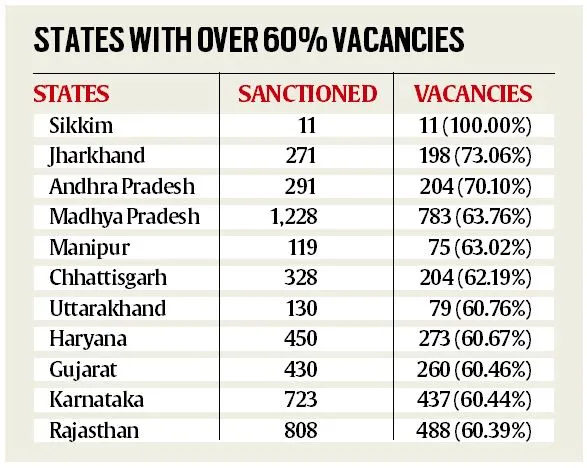Nearly half of all posts in pollution boards vacant, some for decades
The Central Pollution Control Board (CPCB) submitted these details in an affidavit to the National Green Tribunal (NGT) on September 6.
 Only two states -- Nagaland and Arunachal Pradesh -- have no vacancies, with all 17 and 27 sanctioned posts respectively being filled.
Only two states -- Nagaland and Arunachal Pradesh -- have no vacancies, with all 17 and 27 sanctioned posts respectively being filled.Nearly half the sanctioned posts in the State Pollution Control Boards (SPCBs) and Pollution Control Committees in Union Territories (PCCs) across the country are lying vacant. While 11 states have over 60% vacancies, Sikkim tops the list with all posts yet to be filled.
The Central Pollution Control Board (CPCB) submitted these details in an affidavit to the National Green Tribunal (NGT) on September 6.
According to the affidavit, of the total 11,562 sanctioned posts in all SPCBs and PCCs, 5,671 (49.04%) posts have been left unfilled. While some of these posts have been vacant for a month or so, others have been vacant for decades — at least one post in the Punjab SPCB has been vacant for over 35 years (423 months).
Only two states — Nagaland and Arunachal Pradesh — have no vacancies, with all 17 and 27 sanctioned posts respectively being filled.
The states with the most vacancies are Sikkim (100%), Jharkhand (73.06%), Andhra Pradesh (70.10%), Madhya Pradesh (63.76%) and Manipur (63.02%) (see chart). In an affidavit to the NGT, the Sikkim government said the recruitment process has been kept “on hold” as the state has been “unable” to allocate funds.
Sikkim has the smallest SPCB with only 11 sanctioned posts, while the Madhya Pradesh SPCB has the largest sanctioned strength with 1,228 posts, of which 783 are vacant “due to court proceedings”.
 Over 60% vacancies in 11 states, 100% in Sikkim: CPCB to NGT
Over 60% vacancies in 11 states, 100% in Sikkim: CPCB to NGT
The CPCB and SPCBs were established under the Water (Prevention and Control of Pollution) Act, 1974. Under this Act, the responsibilities of SPCBs included conducting investigations and research regarding water pollution, advising the state government on matters concerning water pollution, and monitoring compliance with the law. Besides administrative staff, the boards include posts for technical members like scientists and engineers.
In the decades since, the responsibilities of the CPCB and SPCBs have been expanded with more legislation on environmental issues. These boards are now tasked with taking on similar duties regarding air pollution, environmental protection, waste management (including hazardous, biomedical and solid waste) and noise pollution among other issues.
Speaking to The Indian Express, environmental lawyer and activist Akash Vashishtha said: “Pollution control boards are very important scientific bodies. They have increasingly assumed the position of a scientific institution and require upgraded and advanced infrastructure for testing and sampling to tackle the current pollution scenario.”
“Unfortunately, these boards are struggling with resources in terms of manpower. In the current legal framework, these boards are required to conduct quarterly and even monthly sampling exercises in the case of some important water bodies. When you don’t have the scientists and engineers, how will you be able to collect samples, much less conduct the necessary testing. In rural areas, they rely on important water bodies for both drinking and irrigation purposes. Without sampling and testing, how will you be able to ensure these resources are free of pollution and safe for consumption,” he said.
Setting a deadline, the NGT, on September 11, directed all states and UTs to fill the vacancies by April 30 next year. This, however, does not include Punjab, Delhi and the states with areas in the National Capital Region (NCR) — Haryana, Uttar Pradesh and Rajasthan.
Vacancies in SPCBs in these states and PCC in Delhi are already the subject of an ongoing case in the Supreme Court. According to the latest data, over half the sanctioned posts (53.68%) at the SPCBs and PCC in the NCR are lying vacant – 1,253 of the 2,334 sanctioned posts. In Rajasthan and Haryana, the vacancies go up to over 60%.
When the NCR situation was flagged in the Supreme Court by Senior Advocate Aparajita Singh on April 22 this year, 56.15% of the sanctioned posts were lying vacant. The court then directed the four NCR states and Punjab to file affidavits specifying the number of vacant posts and the steps taken to fill them.
On August 27, a bench of Justices Abhay S Oka and Augustine George Masih said: “Today, the situation is that due to a large number of vacant posts in the State Pollution Control Boards, the said boards have become ineffective for all purposes”. Noting that stubble burning and pollution would become an issue in the region “very soon”, the court set a deadline for filling the vacancies. “Under no circumstances, we are going to grant them time for filling all the vacancies beyond April 30, 2025,” the court said.
The Supreme Court is set to hear the case again on September 27.
Over the past year, both the Supreme Court and the NGT have been monitoring states’ efforts to fill these vacancies. The NGT began monitoring SPCB vacancies in November last year, after taking suo motu cognizance of a media report. In a subsequent report submitted to the NGT on November 22 last year, the CPCB said over half of all sanctioned posts were vacant (50.8%).







